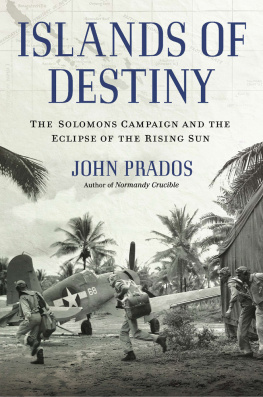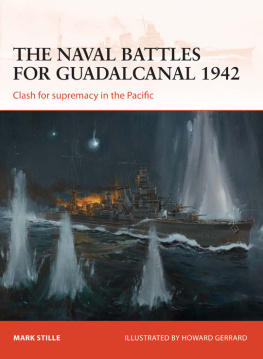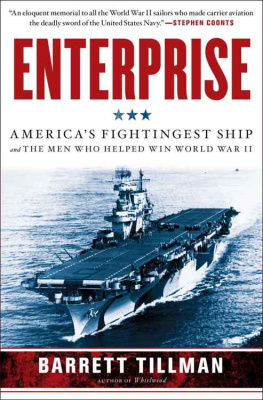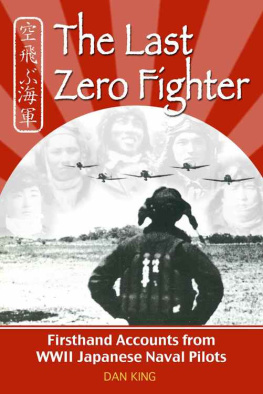The First Team and the Guadalcanal Campaign
The First Team
and the
Guadalcanal Campaign
Naval Fighter Combat from August to November 1942
JOHN B. LUNDSTROM
NAVAL INSTITUTE PRESS ANNAPOLIS, MARYLAND
This book has been brought to publication
with the generous assistance of Edward S. and Joyce I. Miller.
Naval Institute Press
291 Wood Road
Annapolis, MD 21402
1994 by the United States Naval Institute
All rights reserved. No part of this book may be reproduced or utilized in any form or by any means, electronic or mechanical, including photocopying and recording, or by any information storage and retrieval system, without permission in writing from the publisher.
First Naval Institute Press paperback edition, 2005
ISBN 978-1-61251-165-8
The Library of Congress has cataloged the hardcover edition as follows:
Lundstrom, John B.
The first team and the Guadalcanal campaign : naval fighter combat from August to November, 1942 / John B. Lundstrom.
p. cm.
Includes bibliographic references and index.
1. World War, 19391945Aerial operations, American. 2. World War, 1939Naval operations, American. 3. Guadalcanal Island (Solomon Islands), Battle of, 19421943. I. Title.
D790.L79 1993
940.544923dc20
93-8184
16 15 14 13 12 11 9 8 7 6 5 4
To Sandy and Rachel, who make it all possible
John B. Lundstroms First Team and the Guadalcanal Campaign is an enthralling, well-documented, nonjudgmental sequel to The First Team. Like his initial volume, it presents in intimate detail the intense, punishing combat action as it occurred, offering valuable insights into those difficult early flattop engagements in support of our tenuous foothold on Guadalcanal.
One of the most fascinating chapters of the carrier war in the Pacific was the magnificent exploits of a small number of naval aviators who played a vital role in helping bring to a standstill the powerful Japanese thrust in the southern Solomons. Orphaned by costly carrier sea battles, including the sinking of the Wasp and Hornet and battering of the Enterprise, these much-needed fliers and their aircraft were gratefully welcomed ashore to operate alongside their Marine and Army Air counterparts from a rough-and-ready jungle airfield located precariously near the front lines on Guadalcanal. They provided a terrific boost to the beleaguered shore-based contingents holding the line. After a crucial three-month series of bitter, retaliatory air battles, this CACTUS Air Force succeeded; a determined enemy was forced to abandon its plans to retake Guadalcanal.
Because our air and ground efforts were defensive in nature, it is difficult to assess fairly the general progress of our carrier operations during this period. They had little going for them, but this special breed swallowed hard and made sure that it would be enough to stem the tide until Americas industrial might made possible the scheduled 1943 phase-in of the new Essex- and Independence-class carriers with their improved fighter aircraft. Many of our imaginations were captured by the impressive enemy plane tallies compiled by shore-based Marine fighter pilots Joe Foss, John Smith, Bob Galer, and Marion Carl at Guadalcanal. It seems fitting to note also that with a little more ammo and alert fighter help Swede Vejtasa, one of VF-10s unsung heroes, might have run his score to an even dozen in one day off the Big E at the Battle of Santa Cruz, instead of having to settle for only a miserly seven on that one flight.
Realizing that statistics do not always tell the whole story in regard to the loss ratio in fighter-to-fighter combat, it would be prudent to recognize that in most of our early engagements our fighters were outnumbered. Battle losses tended to even out by the end of 1942, when the availability of fighter aircraft on our side improved substantially. As regards the change of quality of naval carrier pilots, Japans pilot training program did not meet its mass-production requirements. When the war began, their pilots were trained to a high degree of combat efficiency. But after heavy attrition and the destruction of the best carrier squadrons, there were insufficient quality replacements to remain combat ready. Japanese carrier aviation never seemed to recover from the heavy casualties suffered in 1942. This produced a new uncertainty in subsequent aerial combat, of course: not knowing if one was going to face a wily veteran or a raw recruit.
Many lessons were learned from the experiences of the First Team in the early days of the war. With the distinct advantage of a dominant fighter aircraft, those of us who followed in Hellcats and Corsairs had all the confidence in the world to fly aggressive-smart against a highly dedicated enemy. Our First Team predecessorswith special credit to our fighter leaders, Jimmy Thach, Jimmy Flatley, and Butch OHarehave earned our heartfelt thanks.
Cdr. Alex Vraciu, USN (Ret.)
The present work concludes the history of U.S. naval fighter combat during the first year of the Pacific War, December 1941 through November 1942. Unlike the first six months, the carriers enjoyed no sudden, stunning victories such as in June at Midway. Both the U.S. and Japanese naval aviators had taken the measure of each other. There would be no surprises now; the struggle entered a new phase. Instead of conducting a mobile defense, the U.S. flattops had to support the first Allied amphibious offensive in the southern Solomon Islands. The initial seizure on 78 August 1942 of a foothold on Guadalcanal occurred rather easily, but the Japanese reacted fiercely. The U.S. Pacific Fleet strained its resources to the limit trying to protect and supply the Marines, sailors, and soldiers who tenaciously held that narrow coastal area. During the course of the Guadalcanal campaign, the U.S. carriers fought two frustrating and costly battles with their Japanese counterparts. Tactical defeats became transformed into strategic victories afterward only because the Japanese did not or could not continue to advance against Guadalcanal. Stripped from flattops that were either blasted under the sea or sent home for repairs, carrier aviators fought from a primitive jungle airfield alongside their Marine and Army Air Force counterparts. American sea, land, and air power proved just enough to increase Japanese attrition and force them to cut their losses and evacuate Guadalcanal. The course of the Pacific War had turned against Japan for good.
The aim of this work is to use the detailed experiences of the naval fighting squadrons to illuminate the general progress of carrier operations. Unlike the dive and torpedo bombers, the fighters fought largely a defensive war. They protected the task forces and acted as escorts on strike missions, with the attack planes entrusted to their care. Their effectiveness and numerical strength largely determined where the carriers could go and how long they could stay there, elements of extreme strategic importance not often properly considered when evaluating carrier commanders such as VAdm. Frank Jack Fletcher. Unlike the carrier battles of 194345, where the U.S. naval fighter squadrons enjoyed both qualitative and numerical superiority, the offensive of 1942 had to be prosecuted in fighters inferior in performance to the Japanese. Gunnery training and tactical doctrine proved to be the decisive factors.









